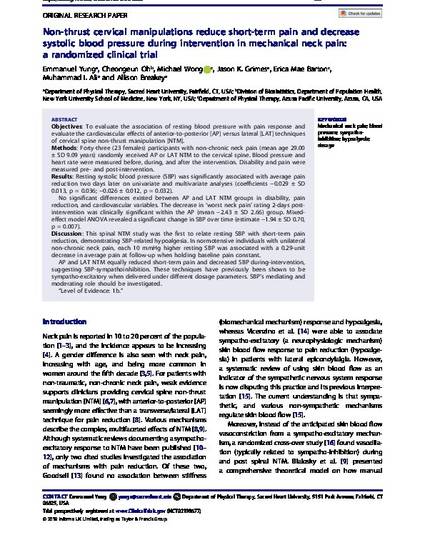
Objectives: To evaluate the association of resting blood pressure with pain response and evaluate the cardiovascular effects of anterior-to-posterior [AP] versus lateral [LAT] techniques of cervical spine non-thrust manipulation [NTM].
Methods: Forty-three (23 females) participants with non-chronic neck pain (mean age 29.00 ± SD 9.09 years) randomly received AP or LAT NTM to the cervical spine. Blood pressure and heart rate were measured before, during, and after the intervention. Disability and pain were measured pre- and post-intervention.
Results: Resting systolic blood pressure (SBP) was significantly associated with average pain reduction two days later on univariate and multivariate analyses (coefficients −0.029 ± SD 0.013, p = 0.036; −0.026 ± 0.012, p = 0.032).
No significant differences existed between AP and LAT NTM groups in disability, pain reduction, and cardiovascular variables. The decrease in ‘worst neck pain’ rating 2-days post-intervention was clinically significant within the AP (mean −2.43 ± SD 2.66) group. Mixed-effect model ANOVA revealed a significant change in SBP over time (estimate −1.94 ± SD 0.70, p = 0.007).
Discussion: This spinal NTM study was the first to relate resting SBP with short-term pain reduction, demonstrating SBP-related hypoalgesia. In normotensive individuals with unilateral non-chronic neck pain, each 10 mmHg higher resting SBP was associated with a 0.29-unit decrease in average pain at follow-up when holding baseline pain constant.
AP and LAT NTM equally reduced short-term pain and decreased SBP during-intervention, suggesting SBP-sympathoinhibition. These techniques have previously been shown to be sympatho-excitatory when delivered under different dosage parameters. SBP’s mediating and moderating role should be investigated.
“Level of Evidence: 1b.”
Yung, E., Oh, C., Wong, M., Grimes, J. K., Barton, E. M., Ali, M. I., & Breakey, A. (2020). Non-thrust cervical manipulations reduce short-term pain and decrease systolic blood pressure during intervention in mechanical neck pain: a randomized clinical trial. The Journal of Manual & Manipulative Therapy, 28(2), 82–93. Doi: 10.1080/10669817.2019.1646985

Muhammad I. Ali and Allison Breakey graduated from Sacred Heart University Doctor of Physical Therapy program.
Open access version downloaded from the PubMed website https://pubmed.ncbi.nlm.nih.gov/31379301/